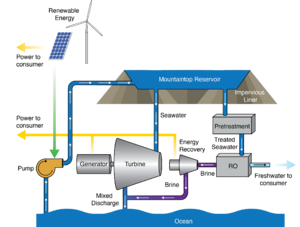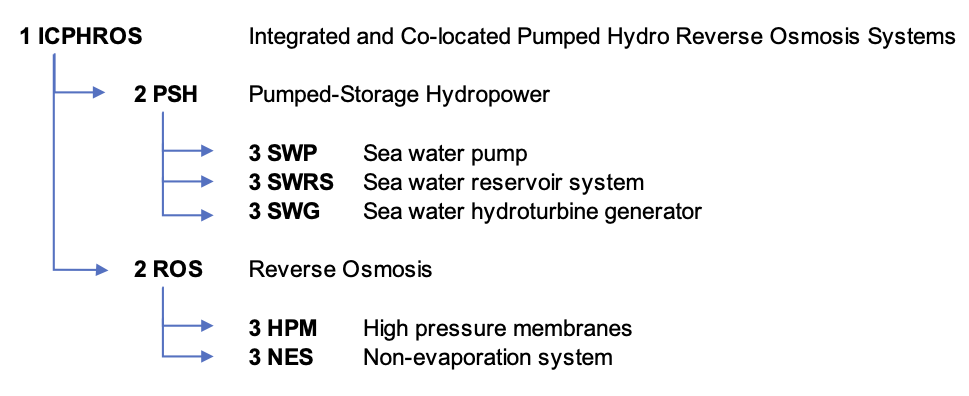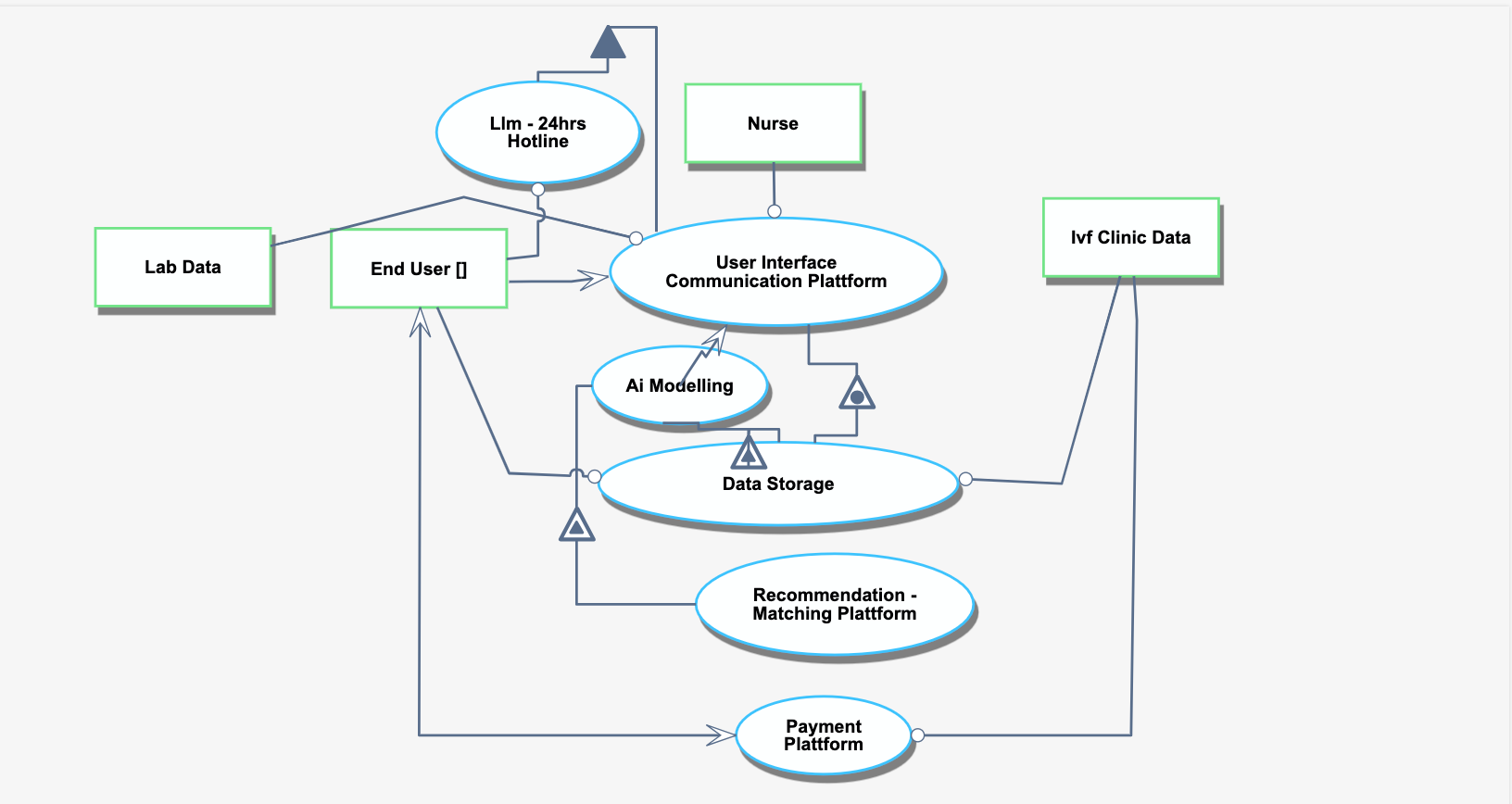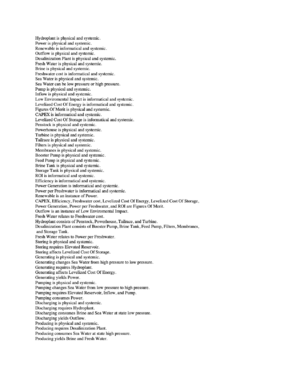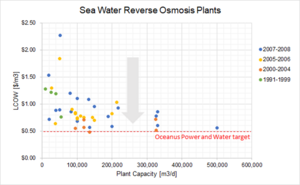Integrated and Co-located Pumped Hydro Reverse Osmosis Systems
Roadmap Overview
- 1ICPHROS - Integrated and Co-located Pumped Hydro Reverse Osmosis System
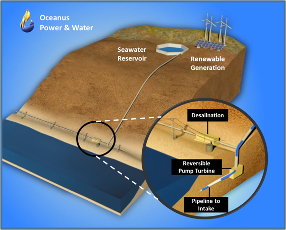 <ref>Oceanus Power & Water. https://www.oceanus.pw/. Accessed 27 Oct. 2020.</ref>
<ref>Oceanus Power & Water. https://www.oceanus.pw/. Accessed 27 Oct. 2020.</ref>
The integration and co-location of pumped hydro storage, hydropower and reverse osmosis desalinization plants optimizes efficiency and offsets capital investments, reoccurring operations and maintenance costs and reduces risk to investors. Low cost, excess renewable energy is used to pump seawater up to an elevated reservoir. When demand exceeds renewable power generation, the elevated seawater is fed to hydro turbines at pressure to generate electrical power to the grid. A small portion of the pressurized water is concurrently routed to the reverse osmosis desalinization plant without the need for duplicative generators to produce freshwater. Finally, the brine residual produced during the desalinization process is mixed with the outflow of the hydro turbines, diluting the environmentally harmful solution before its return to the ocean.
Design Structure Matrix (DSM) Allocation
Object Process Diagram - OPD
We provide an Object-Process-Diagram (OPD) of the 1ICPHROS roadmap in the figure below. The OPD depicts the pumped hydro storage and power technology and its integration with a reverse osmosis desalination plant powered by renewable energy sources. The diagram provides system decomposition into subsystems, processes, inputs, outputs, and the system's characterization by Figures of Merit (FOMs).
An Object-Process-Language (OPL) description of the OPD is displayed below. It is a formal language interpretation of the OPD provided above.
Figures of Merit (FOM)
The table below lists the FOMs by which Integrated and Co-located Pumped Hydro and Reverse Osmosis systems can be assessed. The hydropower industry uses Power Generation and the Levelized Cost of Energy as primary FOMs. The desalination industry uses Power per Freshwater and Cost per Freshwater as primary FOMs. The integration of these two systems does not have a FOM exclusive to this technology and so these four primary FOMs are used to track this technology's advancement over time and compare to stand-alone pumped hydropower and reverse osmosis desalination plants.
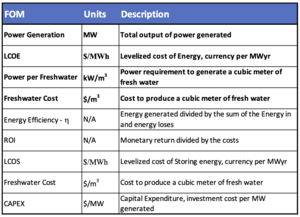
Alignment with Company Strategic Drivers
Integrated pumped hydropower and reverse osmosis systems require co-location to achieve necessary efficiencies, utilize sustainable power sources for pumped hydro storage applications and reduced capital investment in the plant, equipment and brine diffusion process. These integrated plants best serve communities seeking a reliable, sustainable and cheap power source as well as freshwater supply for populations and agriculture use. However, the topography further limits operations as the water source must be optimally located within 3 km of the reservoir, and the reservoir must have a 400 m elevation change from the desalination and hydropower plant. Oceanus Power and Water, LLC (Oceanus) is the only known business operating in this domain. Oceanus seeks to increase the applicability of this integrated business strategy and technological advancements in penstock construction and coating materials as well as turbine efficiencies can expand their markets. Furthermore, water production and power demand optimizations are needed to maximize efficiencies and deliver capital investment savings, reduce generation and operating cost and negate environmental liabilities. The system benefits are not exclusive to cost savings. There are significant benefits, both monetary and environmental with the ability to diffuse the concentrated brine discharge from the desalination plant with outflow from the hydro turbines. California's current EPA standards are the global goal to minimize submarine environmental impacts.
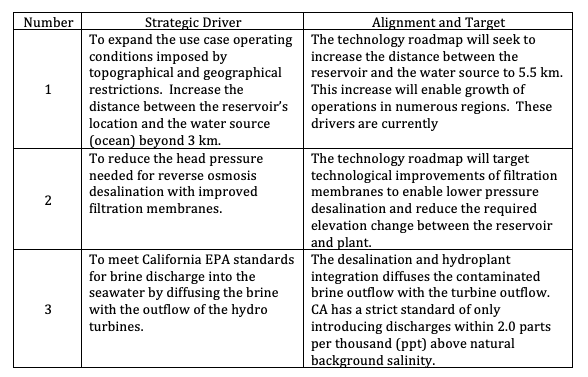 <ref>Water Quality Control Plan Ocean Waters of California, 2015. p. 107.</ref>
<ref>Water Quality Control Plan Ocean Waters of California, 2015. p. 107.</ref>
Positioning of Company vs. Competition
This integrated technology does not compete equivalently against stand-alone hydropower plants or reverse osmosis desalination plants because roughly 95% of the reservoir’s water is used for hydropower generation and 5% for freshwater production. Rather, it is the co-location and integration that yields greater efficiencies, reduced capital investments, cheaper production of energy and water than the stand-alone plants. Therefore, the FOMs for hydropower plant generation [kWh] and the power required to produce freshwater [kWh/m3] cannot be accurately compared. The roadmap sponsor, Oceanus Power and Water, has not completed its first development of this integrated technology in Chile and therefore does not have information regarding their LCOE or LCOW. However, the figure below provides a look at the tradespace between LCOW and Plant Capacity.
The Figure below compares ....
Technical Model: Morphological Matrix and Tradespace
Morphological Matrices for the Pumped Hydro storage and Sea Water Reverse Osmosis systems with multiple variables and applicable ranges are provided below.
FOM #1: Stored Energy - PSH (Pumped-storage hydroelectricity)
The governing equation for Stored Energy, PSH (Pumped-storage hydroelectricity), is provided below and its derivatives were performed. The equation represents the physical phenomenon of the stored energy. For an integrated plant such as this project (co-located sea water storage and reverse osmosis plant) approximately 5% of the stored water is reserved for the reverse osmosis plant. The governing equation and partial derivatives is provided below as part of our analysis:
We chose the following design vector for calculation purposes. Design Vector ρ𝑤𝑎𝑡𝑒𝑟 = 1020 kg/m3 V𝑟𝑒𝑠𝑒𝑟𝑣𝑜𝑖𝑟 = 106 m3 hℎ𝑒𝑎𝑑 = 400 m η𝑠𝑦𝑠𝑡𝑒𝑚 = 0.8
We normalized and found the following relationships exhibited in the graph below:
Because the sensitivity of all variables was 1 for the Pumped Storage Hydropower FOM, we conducted a sensitivity analysis based on the range of the values of each variable (shown in table below) derived from our Morphological Matrix. The range of data was discovered in our literature review and during the meetings we held with the Roadmap sponsor.
The Stored Energy is highly dependent on the reservoir’s volume and height and less dependent on the efficiency of the storage system. These factors are directed related to the siting and location of the project installation and operation. Based on our paper/article research, we found that the location of the project will determine many key variables such as:
- Distance to the water source, which affects the efficiency of the system as longer distances represent higher dynamic losses.
- Natural topography and geology of the coast as it determines the height and the size of the reservoir.
- Market variables, which are not included in the governing equation, such as the existing demand for energy supply during peak hours and excess renewable energy available for storage.
It makes sense that the equation and the sensitivity analysis corroborate what we found in our research. Once the location is chosen, the dimensions of the variables of height and volume are determined. Following siting, the efficiency of the system is where technology improvements represent benefits to the projects.
Key Publications and Patents
Publications
1. Slocum, Alexander H., et al. “Integrated Pumped Hydro Reverse Osmosis Systems.” Sustainable Energy Technologies and Assessments, vol. 18, Dec. 2016, pp. 80–99. ScienceDirect, DOI:10.1016/j.seta.2016.09.003.
Slocum et al. assessed integrated pumped hydro reverse osmosis systems as a “symbiotic match” between pumped hydropower and storage and desalination using reverse osmosis. The article explores the topographical restrictions for application of this integrated solution and concludes that there are many benefits to the co-location and integration of these existing technologies.
2. Bowen Zhou, Boyu Liu, Dongsheng Yang, Jun Cao, Tim Littler. Multi-objective optimal operation of coastal hydro-electrical energy system with seawater reverse osmosis desalination based on constrained NSGA-III. Energy Conversion and Management, Volume 207, 2020, 112533, ISSN 0196-8904, https://doi-org.ezproxyberklee.flo.org/10.1016/j.enconman.2020.112533.
This recent article explores the optimization of the integrated system. The non-dominated sorting genetic algorithm (NSGA-III) is employed to optimize the cost of the hydro-electrical energy system and look at the sensitivity of the various parameters involved with desalination. It applied these results to 5 case studies and concluded that the algorithm can find the Pareto front and that the entire system should be evaluated to find the optimal implementation and operational approach.
3. Rehman, Shafiqur, et al. “Pumped Hydro Energy Storage System: A Technological Review.” Renewable and Sustainable Energy Reviews, vol. 44, Apr. 2015, pp. 586–98. DOI.org (Crossref), DOI:10.1016/j.rser.2014.12.040.
A recent review of pumped hydro energy storage systems using alternative sustainable energy sources including photovoltaic and wind turbines provides excellent insight and a recent status of the pumped hydroelectric power generation capability. This article concluded the topographical restrictions for this technology are simplified to the ratio of the distance between the reservoir (L) and power plant and the elevation change (H) or L/H. Cost-effective plants currently being built and operated have an L/H ratio of less than 10.
4. Segurado, R., et al. “Optimization of a Wind-Powered Desalination and Pumped Hydro Storage System.” Applied Energy, vol. 177, Sept. 2016, pp. 487–99. ScienceDirect, DOI:10.1016/j.apenergy.2016.05.125.
This article seeks to optimize the integration of pumped hydropower/hydro storage and desalination. The authors use the Direct MultiSearch method to find the optimal sizing and implementation strategy for the integrated system. The analysis yields a Pareto front using power costs and water supply costs as parameters in tension while using wind power for desalination and pumped hydro storage.
5. 106380.Pdf | Powered by Box. https://anl.app.box.com/s/tphlklclz9xu5lv79n2gzv2cfauuvmwv. Accessed 26 Oct. 2020.
Pumped Storage Hydropower: Benefits for Grid Reliability and Integration of Variable Renewable Energy published by the Argonne National Laboratory in August 2014 assessed the viability of pumped hydropower and hydro storage. It concluded that this technology is “a proven, cost-effective solution to large-scale energy storage.” It also discussed ancillary benefits and encouraged the conversion from fixed-speed to variable-speed turbine technologies.
6. The Cost of Desalination - Advisian. www.advisian.com, https://www.advisian.com:443/en/global-perspectives/the-cost-of-desalination. Accessed 26 Oct. 2020.
This article provides an overview of the desalination process and its history since the 1960s. There is incredible growth around the world in the desalination process. Concerning costs, it used an important figure of merit cost to produce a cubic meter of freshwater [USD$/m3]. It gave estimates ranging from $0.70/m3 to $3.20/m3, mostly dependent on the capacity of the plants. Most interesting was the CAPEX breakdown for each of the reverse osmosis salination subprocesses (i.e. pretreatment, brine discharge or storage).
Patents
1. US 2018/0290902 A1 – US Patent Application - Integrated system for generating, storing and dispensing clean energy and desalinating water. Applicant Oceanus Power and Water. The US patent application was published in October 2018 and in the review process. It claims novelty of the integration of existing technologies, pumped hydropower and desalination, as well as solar and wind power generation plants to generate power for a co-located and integrated system. This patent explicitly states that the system consists of a hydraulic storage facility, desalination plant and a penstock that connects the storage facility and desalination plant. This patent could be expanded in the future to address advancements in penstock coatings or materials.
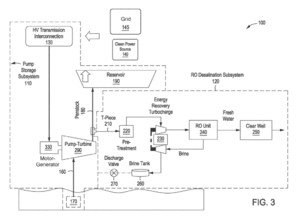
2. WO 2018/191163 A1 – International Publication – An Integrated System for Supplying Clean Water and Clean Energy to the Mining industry. Applicant: Oceanus Power and Water. This international patent application was filed in published in October 2018 and is under review. It claims novelty of the integration of pumped hydropower with processing ore feedstock in mining operations including the treatment of contaminated water. The application of the integrated system is specific to mining operations which require significant energy for “excavation, crushing, milling and transportation,” as well as freshwater for mineral and petroleum product extraction.
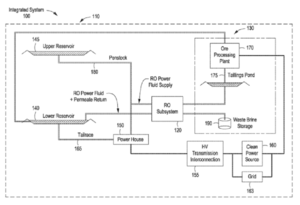
3. US 2019/0046931 A1 – US Patent Application – Separation membrane. Applicant Toray Industries, Inc. The patent application was received in 2019 is outstanding and in the review process. It provides a novel approach to a separation membrane necessary for reverse osmosis (RO) desalination processes. It evolves on an existing invention regarding separation membranes and reducing the number of defects. Advancements in membrane technology can enable RO with lower pressures or minimize the need for pre-treatment at low pressures (at the reservoir). This patent introduces a separation membrane to reduce defects in the current membrane system. There are efforts underway to use ceramic-based membranes to enable lower pressure RO.
